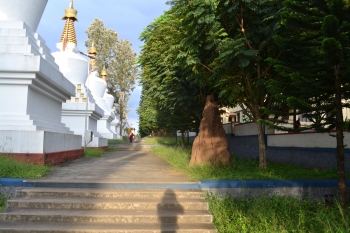 A termite mound flourishes in a Tibetan Buddhist Monastery in India. From Tinley Fynn.
A termite mound flourishes in a Tibetan Buddhist Monastery in India. From Tinley Fynn.It’s been several years since I read Heinrich Harrer’s classic, Seven Years in Tibet (1953).
Amidst Harrer’s dramatic journey through Tibet’s soaring mountain peaks, harrowing political landscape, and deeply religious backdrop, one humble passage (p. 169) resonated. Harrer describes his encounter with a Tibetan community, observing their daily interactions with their surrounding natural environment and reveals their deep acknowledgement and ability to live harmoniously with all life forms. The passage wonderfully demonstrates the everyday application of the Buddhist principle of ahimsa, to cause no injury and to do no harm. Harrer marvels at the way the Tibetans would exert
themselves breaking through frozen pools to save the fish in buckets before the pools froze completely; how, if a bug was to crawl up someone’s leg, they would without a thought, remove it and place it on the ground and the way it was “a catastrophe when a fly falls into a cup of tea.”
As I read how Harrer wondered at the novelty of such a way of life, as a Buddhist, these were the instinctive reactions I had been brought up with. Witnessing others haphazardly swat a fly or walk passed a struggling creature filled me with shock and distress. I remember vividly spending hours of my childhood carefully removing the slugs from my auntie’s garden and walking with her to the nearby reservoir to find a new home for the creatures. I also remember how she would take me on evening walks in the rain to look for worms and snails that had wandered onto the roads and remove them from the danger of passers by and the times she would come home with injured animals to nurse them lovingly back to health. But reading the passage also made me realise that as I have grown older I have become less and less aware of all these other life forms we live with, more scarcely noticing the worm or snail on the road and if I’m honest, the fly falling into the cup of tea became just a little bit less of a tragedy.
As His Holiness the Dalai Lama describes in his book An Open Heart: Practicing Compassion in Everyday Life, the concept of non-violence “…. is not merely the absence of violence. It involves a sense of compassion and caring.” In this way, our understanding of compassion should not be limited to the avoidance of committing harm or injury upon another but should also extend to and incorporate a level of awareness of the nature of actions, non-actions and their ethical consequences. Life-preserving actions and the protection and cultivation of all beings we encounter are of equal importance to our understanding of non-violence. To abandon this kind of loving kindness and compassion for sentient beings is to commit one of the fourteen root downfalls, the teachings outlined by Sakya Pandita to offer guidance on keeping one’s samaya vows pure. To hurt or stray from feeling compassion toward another sentient being is to hurt one’s self and ultimately to violate one’s samaya vows.
The old cliché of childhood innocence is likely true. Perhaps it would do us all good to think of ourselves as we were as children to reconnect with our true Buddha nature. Any amount of years studying scriptures becomes redundant when we fail to demonstrate the application of core tenants in our daily lives. It is sometimes the small, and often overlooked, examples of Buddha activity that we can best learn from.















